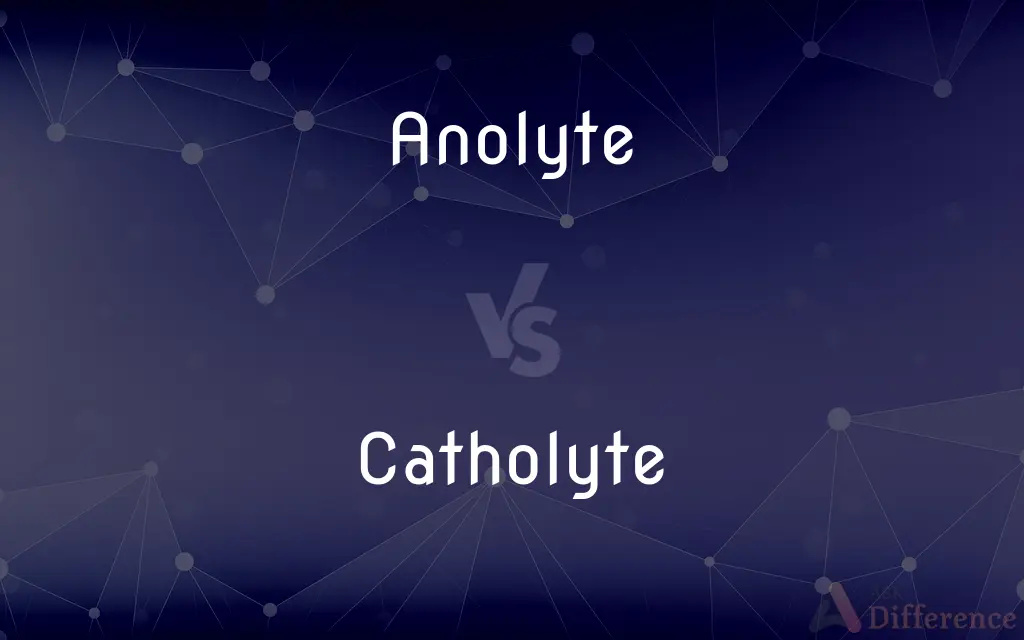Anolyte vs. Catholyte — What's the Difference?
By Tayyaba Rehman & Fiza Rafique — Updated on March 21, 2024
Anolyte and catholyte are electrolyte solutions found at the anode and cathode, respectively, in an electrochemical cell, differing in their charge and role.

Difference Between Anolyte and Catholyte
Table of Contents
ADVERTISEMENT
Key Differences
Anolyte is the electrolyte solution near the anode (positive electrode) of an electrochemical cell, where oxidation reactions occur, releasing electrons. Catholyte, on the other hand, is the electrolyte solution near the cathode (negative electrode), where reduction reactions take place, gaining electrons. The key difference lies in their proximity to the cell's electrodes and the type of reactions they facilitate.
Anolytes often contain positive ions (cations) that are attracted to the cathode, where they may gain electrons. Catholytes typically contain negative ions (anions) that move towards the anode to lose electrons. The composition and properties of anolyte and catholyte solutions can vary significantly depending on the type of electrochemical cell and its application.
In applications like electrolysis, water treatment, or battery technology, the distinction between anolyte and catholyte is crucial for understanding the chemical processes and optimizing performance. For instance, in a redox flow battery, the anolyte and catholyte are stored in separate tanks and pumped through the cell to store or release energy.
The pH levels of anolyte and catholyte can also differ markedly; anolytes tend to be more acidic due to the generation of protons (H⁺ ions) during oxidation, while catholytes may become more alkaline as reduction reactions can produce hydroxide ions (OH⁻).
Comparison Chart
Location in Cell
Near the anode (positive electrode).
Near the cathode (negative electrode).
ADVERTISEMENT
Reaction Type
Facilitates oxidation reactions.
Facilitates reduction reactions.
Ionic Composition
Contains cations moving towards the cathode.
Contains anions moving towards the anode.
PH Level
Tends to be more acidic.
Tends to be more alkaline.
Application
Used in processes like electrolysis, water treatment.
Used in processes like metal plating, energy storage.
Compare with Definitions
Anolyte
Often acidic due to the generation of protons.
The anolyte's acidity increases in water electrolysis as oxygen is produced at the anode.
Catholyte
Often alkaline due to the production of hydroxide ions.
The catholyte becomes more alkaline in electrolysis processes where hydrogen is generated at the cathode.
Anolyte
Electrolyte solution near the anode facilitating oxidation.
In electrolytic chlorine production, the anolyte contains saltwater, producing chlorine gas at the anode.
Catholyte
Electrolyte solution near the cathode facilitating reduction.
In a copper electroplating cell, the catholyte contains copper ions that are reduced and plated onto the cathode.
Anolyte
Contains cations that are attracted to the cathode.
Sodium ions in the anolyte migrate towards the cathode during electrolysis.
Catholyte
Contains anions that move towards the anode.
Chloride ions in the catholyte may migrate towards the anode in certain electrolysis applications.
Anolyte
Can be tailored for specific electrochemical reactions.
Anolyte compositions are optimized for efficiency in redox flow batteries.
Catholyte
Properties adjusted based on application requirements.
Catholyte solutions in batteries are formulated for maximal ion transport and reduction efficiency.
Anolyte
Used in various industrial and chemical processes.
Anolytes are crucial in the electroplating industry for metal oxidation.
Catholyte
Essential for processes like metal recovery and water purification.
Catholytes play a key role in the recovery of precious metals through electrochemical methods.
Anolyte
The portion of an electrolyte near an anode, especially in a cell in which the cathode and anode are in separate compartments
Catholyte
The portion of an electrolyte near a cathode, especially in a cell in which the cathode and anode are in separate compartments
Anolyte
(flow batteries) The liquid anode
Catholyte
(flow batteries) The liquid cathode
Common Curiosities
What safety considerations are there for handling anolytes and catholytes?
Depending on their composition, they can be corrosive or toxic, requiring appropriate safety measures like protective equipment and ventilation.
Why are anolyte and catholyte solutions separated in some batteries?
Separation prevents the mixing of reactants and ensures efficient redox reactions, improving energy storage and conversion efficiency.
Can anolyte and catholyte solutions be the same in some cells?
Yes, in simple electrochemical cells, the anolyte and catholyte can be parts of the same electrolyte solution, but they differ in the vicinity of the electrodes.
How do the pH changes in anolyte and catholyte affect electrochemical processes?
pH changes can influence the solubility of ions, reaction rates, and the stability of the electrolyte, impacting the overall efficiency of the cell.
How do researchers optimize anolyte and catholyte compositions for new applications?
Through experimentation and simulation, researchers tailor electrolyte properties like conductivity, stability, and reactivity for specific applications.
Can the use of specific anolytes and catholytes impact environmental sustainability?
Yes, the choice of environmentally benign and recyclable anolyte and catholyte materials can enhance the eco-friendliness of electrochemical technologies.
Are there any innovations in anolyte and catholyte development for better sustainability?
Yes, ongoing research focuses on developing more sustainable, less toxic, and more efficient electrolyte solutions for various applications.
How are anolyte and catholyte solutions maintained in industrial applications?
They may be regularly monitored and adjusted for concentration, pH, and purity to ensure optimal performance and longevity of the electrochemical system.
How do temperature changes affect anolyte and catholyte behavior?
Temperature can influence reaction kinetics, ion mobility, and electrolyte stability, impacting the efficiency and safety of the system.
What role do anolyte and catholyte solutions play in renewable energy systems?
In systems like redox flow batteries, they are key to energy storage and release, enabling the integration of intermittent renewable energy sources.
Share Your Discovery

Previous Comparison
Demersal vs. Pelagic
Next Comparison
Bit vs. HalterAuthor Spotlight
Written by
Tayyaba RehmanTayyaba Rehman is a distinguished writer, currently serving as a primary contributor to askdifference.com. As a researcher in semantics and etymology, Tayyaba's passion for the complexity of languages and their distinctions has found a perfect home on the platform. Tayyaba delves into the intricacies of language, distinguishing between commonly confused words and phrases, thereby providing clarity for readers worldwide.
Co-written by
Fiza RafiqueFiza Rafique is a skilled content writer at AskDifference.com, where she meticulously refines and enhances written pieces. Drawing from her vast editorial expertise, Fiza ensures clarity, accuracy, and precision in every article. Passionate about language, she continually seeks to elevate the quality of content for readers worldwide.















































